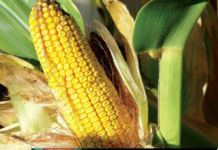Contact: Marsha Boswell, [email protected]
For audio version, visit kswheat.com.
It may seem ironic to be selecting varieties for the next wheat growing season when some in Kansas are still working to harvest the current year’s crop, but the time to plant is just around the corner. Kansas State University recently released the Kansas Wheat Variety Guide 2023 to aid producers in making the critical selection of which varieties will best match the needs of their operations.
This annual publication provides detailed ratings for agronomic characteristics like maturity, height, drought tolerance and straw strength as well as resistance to different diseases. The ratings are compiled based on the results of field and greenhouse tests by both public and private wheat researchers.
Individual variety analysis includes these ratings as well as pedigree, geographic adaption, strengths and weaknesses. The publication also includes suggestions for how producers can use these ratings to minimize production problems and yield losses. This information includes differences in how each variety varies in potential performance across different geographic regions and soil types.
To use the variety ratings, wheat producers should consider the following factors.
First, growers should evaluate how well varieties are adapted for their geographic area, especially in a state with as much climatic diversity as Kansas. While some varieties could perform well across the state, other varieties are specifically adapted for certain regions and may not perform well in other regions.
For example, the guide details “varieties successful in western Kansas tend to have a medium or medium-late maturity and medium height or taller as well as good drought tolerance. In contrast, wheat varieties with early or medium-early maturity, medium or shorter height, and good acid soil tolerance are most successful in central Kansas.”
Next, producers should determine which diseases are the most important to address through built-in resistance. According to the guide, “In western Kansas, wheat streak mosaic, leaf rust and stripe rust are among the most damaging and common diseases…In eastern and central Kansas, the environment is often more conducive for disease development…”
Genetic resistance to insects and/or diseases is a powerful control tool for producers that can reduce the risk of severe disease problems, but not many varieties have resistance to every disease. Producers should know the resistance and susceptibility of the varieties they select to make more informed decisions on other production management decisions like sowing date, volunteer wheat management and fungicide applications to minimize losses.
Finally, growers should determine whether a herbicide-resistant variety is necessary. The guide details wheat varieties with tolerance to grass-controlling herbicides that are part of the Clearfield or CoAXium production systems as well as special considerations for these systems.
Learn more about how to put this guide to work in selecting wheat varieties here.
Find the full wheat variety guide and other resources at kswheat.com/wheatrx. Wheat Rx is a partnership between Kansas Wheat and K-State Research and Extension to disseminate the latest research recommendations for high-yielding and high-quality wheat to Kansas wheat farmers. These publications — like the wheat variety selection guide detailed above — are funded in part by wheat farmers through the Kansas Wheat check-off and are designed to address key management areas of hard winter wheat.
###
Written by Julia Debes for Kansas Wheat




